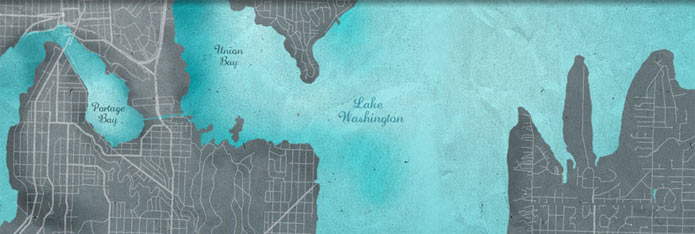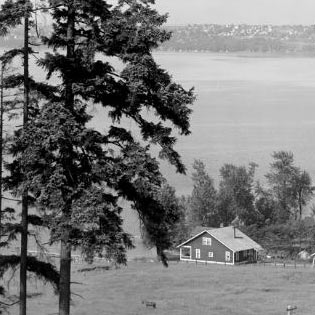AUDIO
MP3 Download: Listen to Michael Luis, life long resident of Medina, author and current Mayor of the city, talk about the history of transportation and the impact of people and goodscrossing the lake.
RESOURCES
- Eastside Heritage Center
- HistoryLink.org essay on Bellevue
- HistoryLink.org essay on Medina
- HistoryLink.org essay on Yarrow Point
Links to external websites do not constitute endorsement by WSDOT of the linked websites or the opinions, information, products or services contained therein.
Medina Heights
Along the eastern shores of Lake Washington, thick, tall trees first drew lumbermen to the area today known as Medina, stretching from Evergreen Point south to Meydenbauer Bay, west of Clyde Hill. In the late 1800s, much of the land along the shoreline was cleared of timber, and berry farms and orchards were developed in the new open spaces. Drawn by the rural charm and excellent views, Seattle businessman Thomas Dabney became Medina’s first permanent settler in 1886. In 1891, Dabney built a dock at what would later be known as Dabney’s Landing, located near present‑day Medina City Hall, attracting other residents to the area. The following year, the new community named its town Medina Heights.
During the early 1900s, more lakeshore estates emerged in Medina Heights. This trend began in 1905 when Edward Webster, the secretary and general manager of Seattle’s Independent Telephone Company, erected a home called “The Gables.” Several similar homes followed and on February 18, 1914, Medina Heights was officially platted with large waterfront tracts. In the following years, the area was promoted as an exclusive residential area, located away from the bustle of city life but close enough to enable the trip into town to be made quickly. A 1913 newspaper advertisement claimed that the trip from Medina to Leschi Park, located on the west side of Lake Washington, could be reached by ferry within 10 minutes and the Smith Tower, a symbol for Seattle commercialism, could be reached within 25 minutes.
Hunts Point and Yarrow Point
Just north of the existing SR 520 Bridge, on the east side of Lake Washington, is the town of Hunts Point. In 1871, Marshall Blinn acquired what is today known as Hunts Point, a finger of land stretching into Lake Washington just east of Medina and north of Clyde Hill. Blinn, a master millwright, came to Seattle in 1854 and soon emerged as a successful lumber and shipping magnate. After Blinn’s death in 1888, Leigh S.J. Hunt bought the property.
Hunt, a high school principal from Iowa, came to Seattle in the 1880s. Joining up first with Jacob Furth, the head of the Seattle National Bank, Hunt soon became involved in real estate, mines, street railways, and banks. In 1886, Hunt bought the Seattle Post-Intelligencer and, with no prior newspaper experience, brought his dynamic force to its operations. Shortly thereafter, Hunt bought land along the eastern shores of Lake Washington, including the areas today known as Hunts Point and Yarrow Point. In 1888, Hunt built a large, 14-room home on the shore of the lake, complete with lawns, barns, gardens, the Yarrow Point fountain, and a park with deer. Hunt named his estate “Yarrow” after a poem by William Wordsworth describing a glorious estate. Thereafter, the arm of land was known as Yarrow Point.
Around 1888, Hunt deeded some land at the base of Yarrow Point to his friend, Jacob Furth, the founder of the Puget Sound National Bank. Furth developed the land, including some of present day Wetherill Nature Preserve, into a country summer estate complete with fruit orchards, vegetable gardens, strawberry fields, and pastures of milk cows and sheep. Furth’s wife named the home Barnabee, after her favorite Shakespearean actor, Henry Clay Barnabee.
In about 1902, Edward P. Temper brought a different kind of agriculture to Yarrow Point. Trading some land on Bainbridge Island for 300 feet of waterfront, Temper began planting English holly on his Yarrow Point property. Waiting 18 years for the holly to mature, Temper planted strawberries between the rows. By 1920, the Temper ranch was finally producing holly and was one of the largest such establishments in the United States. The family continued until just after World War II, when tax rates increased to the point that the holly operation was no longer profitable. In 1960, the Tempers sold the land for real estate development.
The first real estate development on Yarrow Point was made by George F. Meacham. Meacham, a Scotsman, filed the first plat for Yarrow Point in 1907. Giving the streets Scottish names, Meacham’s development began the community’s trend toward suburban living rather than agricultural production. Although other small agricultural operations existed on Yarrow Point in the early nineteenth century, rising costs and land values led many residents to sell their property for real estate development.
Clyde Hill
Just south of SR 520, and inland from Medina, is the city of Clyde Hill. Patrick Downey homesteaded much of the land that now makes up Clyde Hill in 1881. Born in Ireland, Downey came to the United States in 1860 and tried his luck in the gold mines of California. Eventually, Downey settled in the Seattle area, taking up a claim on a ridge on the eastern shore of Lake Washington and building a log cabin. In 1890, President Benjamin Harrison, or more likely his proxy, signed Downey's land grant, after he proved up his claim.
In the early years, Downey named a local dock on Meydenbauer Bay “Clyde Landing” after the Clyde River in Scotland. This name was later adopted by the community of Clyde Hill that grew up around him. Downey married an Iowa native, Victoria, and brought her to the new home in 1892. After he cleared the land, Downey started a strawberry farm and large dairy with 30 to 40 cows. As the family grew, eventually having a total of 13 children, the Downeys built a new home in August 1903, which still stands today.
With the growth of the Downey family and the arrival of more settlers, public services were needed in the area. The first school in the area had an enrollment of nine children and was started in 1886 in one of the Downey’s berry field outbuildings. This building was used during the summer while a one-room building on Bellevue’s main street was constructed by local residents, including Downey.
Visit Historylink.org to learn more about the Eastside communities of Bellevue, Medinaand Yarrow Point.

